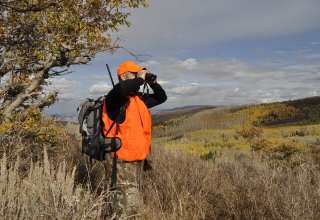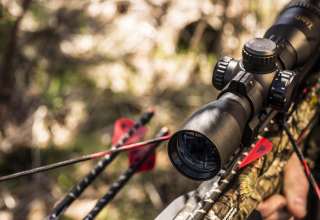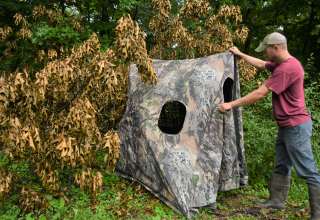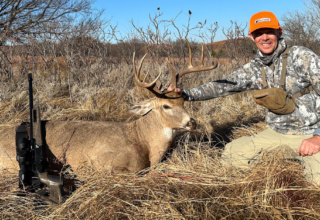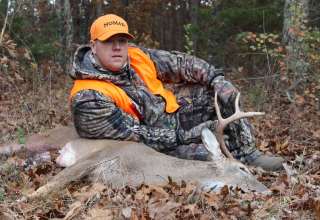One might think that long range shooting with a muzzleloader requires big charges, large bores, and big bullets. Ironically, the secret to anchoring that big buck at 200 yards lies in tiny details. Unlike center-fire rifles in which every bullet shoots the same and aiming is the prime variable, muzzleloaders must fire each bullet in the same way. Once this consistency is reached, count on accuracy that will amaze.
Get to Know Your Rifle
Despite manufacturing uniformity, most center-fire rifles and shotguns of the same make do not shoot alike, the reason that every hunter should dial in his center-fire and turkey hunter should pattern his shotgun. This goes double for muzzleloading rifles. Does your rifle shoot most accurately with pelletized or loose powder? Does the first shot from a clean rifle print the same as a bullet fired without recleaning? Does one brand of 209 primer creates higher velocities than another? Luckily, burning powder in a muzzleloading rifle is pure, smoky fun and experimenting will build your confidence.
These are just a few of the variables that muzzleloading hunters face at long range. If you want to shoot with confidence at 200 yards, get to know your rifle and load it for its highest level of consistency. Examine these critical factors one at a time.
Magnum Charges for Maximum Distance?
Common sense would dictate that the more powder you ignite behind a bullet in a muzzleloader, the faster and farther the bullet will travel. Yes, 100 grains of propellent will produce a greater velocity than 50 grains. However, 150 grains will rarely yield a proportional increase in bullet velocity over 100 grains. Muzzleloading propellants quickly reach a point of diminishing returns to barrel length and amount of powder that burns.
Fans of pelletized power enjoy the ease of dropping three pellets down the muzzle and assume that they will get 1/3 more velocity than with two pellets (100 grains). Mike Matley was the guru of muzzleloading for Knight Rifles in the heyday of “modern muzzleloading.” Matley experimented extensively with powder charges, granular and pelletized, and found that a velocity maxed out at 110 grains of lose powder. Using more did not increase velocity proportionally and created much more fouling in rifles with barrels of 20-24 inches.
Traditions Firearms has taken up the mantra of long range muzzleloading by producing rifles with barrels that are more suited for burning large powder charges. Like a crossbow, the longer barrel gives the bullet a longer “power stroke.” Traditions offers the Vortek StrikerFire™ LDR equipped with the StrikerFire system and a 30″ barrel for when distance counts. This patent-pending rifle weighs in at 6.8 pounds and comes with 209 ignition. Additionally, Traditions makes a Northwest Series of rifles that meet state specific requirement. Several models come with 28 or 30-inch barrels for long distance accuracy and performance. The Traditions Ultralight LDR rifle won Field & Stream’s “Best of the Best” award in 2012, an indication of the line’s performance.
Consistency is Key
Begin the quest for 200 yards at 50. From a solid rest, you should be able to touch bullet holes at 50 yards. Mathematically, a one-inch group at 50 yards will be a four-inch group at 200, an indication of the precision needed to down a buck two football fields away.
Begin with the basics which leads back to knowing your rifle and the gear you use:
 Experiment with bullet types. Powerbelt bullets are known for their easy loading. Other companies such as Hornady and Federal offer easy-loading bullets, yet the easiest bullet to load may not be the most accurate.
Experiment with bullet types. Powerbelt bullets are known for their easy loading. Other companies such as Hornady and Federal offer easy-loading bullets, yet the easiest bullet to load may not be the most accurate.
How does fouling affect bullet strike? Some bullets seem to print more consistently from a dirty barrel. If you clean between shots, do you lubricate the barrel as well? Since a muzzleloader is basically a “one shot” rifle, it’s fine to shoot from a sparkling clean barrel, but it’s prudent to know where a follow-up round will strike, should you need to quickly reload.
Powder loads and types can make a huge difference in accuracy. Pelletized powder is very convenient to shoot and load. Two pellets will probably be closer to 100 grains than granulated powder measured in a traditional blackpowder flask. Test performance with loose and pelletized powers.
Finally, the loading process must be exact. Be sure that the bullet and powder charge are rammed to the same location each time. Mark your ramrod for powder used and be sure that the bullet is seated to that mark each time. After each shot, the greatest fouling occurs at the ignition point and a quick reload may not push the bullet to meet the powder. Break-open models with a “quick release” breech plugs are much easier to clean and unload.
Shooting Skill
Can you print a 4-inch group at 200 yards with a .270 Winchester or .30-06 Springfield? Muzzleloading has many more variables than firing a center-fire rifle, yet basic marksmanship skills such as breath control, trigger management, and maintaining a steady aim are equally important.
Muzzleloading may open an entirely new season of big game action or give you an advantage over shotgun hunters in special seasons. Use the suggestions above to tighten your “short game” and you will be able to reach out and bring home the bacon.
- Long Range Hunting - January 9, 2019
- Travel Smarter with Crossbows - November 24, 2018
- Portable Ambush Blind – The NAP Mantis - September 7, 2018





